Cultural Connections: Norman in Clermont-Ferrand, France debuts on Friday, May 19 as a part of Les Arts En Balade, helping us further the bonds between us and our sister city through culture and art. Here’s a preview of Daren Kendall’s work that will be showcased as part of the exhibition.
Daren Kendall
Jai Pris les Armes Pour la Liberté de Tous (I Took up Arms For the Freedom of All)
Concrete, steel, wood, glass, vulcanized rubber, Volvic lava stone and mineral water, piano wire, amplifiers, contact microphones, photographs, and plastic.
Texture – Elemental
Daren Kendall’s work in the Chapelle de l’Oratoire gives form to the underlying ideas and beliefs that are central to our understanding of liberty and freedom in both France and the US. Inspired by the Vercingetorix statue at the center of Clermont-Ferrand, he initially found an interesting correlation in the gesture of the Gallic warrior and that of the Statue of Liberty in New York harbor, both created by Auguste Bartholdi. These monumental figures symbolize the quest for liberty and freedom in both France and the US, each posed with one arm extended to declare foundational virtues of individual freedom and independence. This led to further consider the connection between Clermont-Ferrand and Norman as sister cities. The figure of “the seed sower” at the University of Oklahoma is centrally located on campus and garnered as an icon of institutional identity. Created by local sculptor Paul Moore, the bronze figure is symbolic of another kind of liberty, specific to American expansion and manifest destiny. Both the allegorical sower and the historical warrior are reflective of the social function of public sculpture as an expression of cultural identity. Kendall’s work draws from the two monuments to explore their relationship to one another and envisions a sentient machine for the production of liberty and freedom.
The warrior and the seed sower extend their arms in two different directions, one toward the sky above and the other toward the earth below. Each figure is crafted in a frozen forward motion, one to plant life into the ground the other to conquer and overcome foe. In dialogue with each other a kind of corporeal dialectic begins to emerge. Two bodies in gestural opposition, in physical contrast, seem to pursue a similar goal, a utopic ending. They each embody the beliefs of freedom and expansion, beliefs elemental to their identity and to survive. These solitary figures are romantic ideals. Self-determined, they work independently without notions of collaboration and community.
“I am interested in the two figures as a means to question the ideological underpinnings that celebrate the heroic archetypes in the Western canon of sculpture,” said Kendall. “I like the idea of the warrior and the seed sower in conversation, or perhaps working together to reach a common goal. I created an instrument, a sculpture, and a stage, to articulate this idea. The Chapelle de l’Oratoire has become the site to envision a new mythology.”
Two black vertical forms signify two sentient bodies. Eye-shaped slits run vertically up each column and reveal scenes of Clermont-Ferrand as a documentation of the artist’s personal memory. At the base of the column sound is transmitted through a concealed opening. In effect, a closed mouth to transmit the sound of humming. A single piano wire tethers each of the forms to the wall of the site, offering a context and the necessary tension to resonate with sound. Each figure is wrapped in a tight black plastic skin. Bound as if to protect the body from heightened sensation. At the core of each body an image of a human figure is revealed through a hole, one pointing up, the other pointing down toward the ground. Each column mimics the gesture with a length of steel rebar above. On the floor two horizontal concrete columns lead toward a central point. Each foundation is lined with strips of salvaged rubber like tires along a road. These are remnants of a vehicle, a system, and a desire to explore and conquer new territory, by car. A tube of steel conduit rides above the concrete and tires. One end attached to a piano wire, each with it’s own actuator, and at the other end a microphone. Vibration is transported from one end to the other like an electrical circuit or pipeline for transmission. At the center of it all a pile of volvic stone holds a glass of water – half-empty, half-full. Together, the system creates an instrument to activate the two bodies, as well as a site for visitors to move through and create their own sounds.
The result of the instrumental bodies, is that these fabricated beings have a life of their own. Occasionally, when it is very quiet in the Chapelle, one of them will softly begin to hum. Perhaps from some vibration in the earth, undetected by humans? Or maybe a fly brushed by a wire? Whatever the cause, the being serves to remind us of how uncontrolled technology can be. We can create it, but we cannot always control it. While the assistance of technology can offer a freedom to humans, it can also be our doom. This idea is related in the half full/half empty wine glass at the core of the installation.
Through this installation, Kendall has explored the 4 textural elements that make up the identity of Clermont-Ferrand and represent the four elements of the world: The local Volvic Water (water), Volvic Formations (fire), the tire industry (Earth), and Vibrations (wind).
The artist invites the viewer to experiment with the machine. Vibrations will cause differing hums to emanate. A gentle tap on the piano wire or the rebar arms, a light drumming on the vertical columns.


